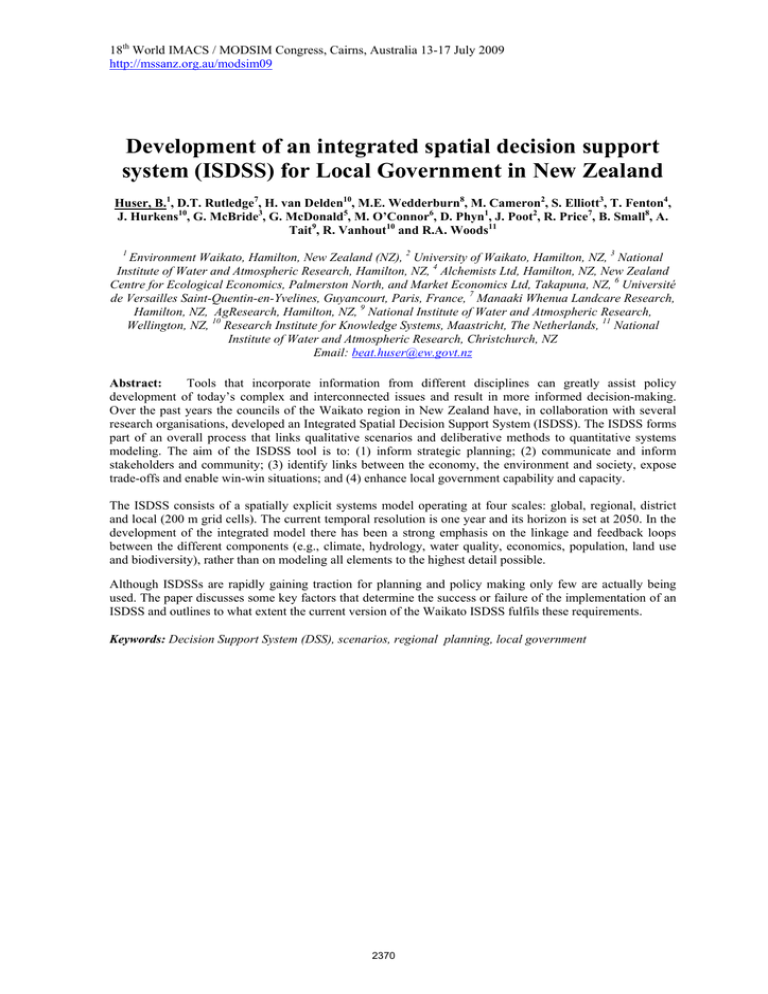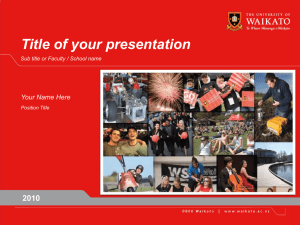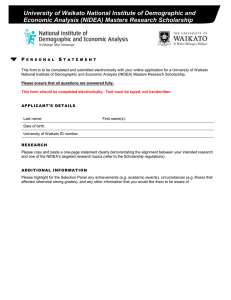Development of an integrated spatial decision support system (ISDSS)
advertisement

18th World IMACS / MODSIM Congress, Cairns, Australia 13-17 July 2009 http://mssanz.org.au/modsim09 Development of an integrated spatial decision support system (ISDSS) for Local Government in New Zealand Huser, B.1, D.T. Rutledge7, H. van Delden10, M.E. Wedderburn8, M. Cameron2, S. Elliott3, T. Fenton4, J. Hurkens10, G. McBride3, G. McDonald5, M. O’Connor6, D. Phyn1, J. Poot2, R. Price7, B. Small8, A. Tait9, R. Vanhout10 and R.A. Woods11 1 Environment Waikato, Hamilton, New Zealand (NZ), 2 University of Waikato, Hamilton, NZ, 3 National Institute of Water and Atmospheric Research, Hamilton, NZ, 4 Alchemists Ltd, Hamilton, NZ, New Zealand Centre for Ecological Economics, Palmerston North, and Market Economics Ltd, Takapuna, NZ, 6 Université de Versailles Saint-Quentin-en-Yvelines, Guyancourt, Paris, France, 7 Manaaki Whenua Landcare Research, Hamilton, NZ, AgResearch, Hamilton, NZ, 9 National Institute of Water and Atmospheric Research, Wellington, NZ, 10 Research Institute for Knowledge Systems, Maastricht, The Netherlands, 11 National Institute of Water and Atmospheric Research, Christchurch, NZ Email: beat.huser@ew.govt.nz Abstract: Tools that incorporate information from different disciplines can greatly assist policy development of today’s complex and interconnected issues and result in more informed decision-making. Over the past years the councils of the Waikato region in New Zealand have, in collaboration with several research organisations, developed an Integrated Spatial Decision Support System (ISDSS). The ISDSS forms part of an overall process that links qualitative scenarios and deliberative methods to quantitative systems modeling. The aim of the ISDSS tool is to: (1) inform strategic planning; (2) communicate and inform stakeholders and community; (3) identify links between the economy, the environment and society, expose trade-offs and enable win-win situations; and (4) enhance local government capability and capacity. The ISDSS consists of a spatially explicit systems model operating at four scales: global, regional, district and local (200 m grid cells). The current temporal resolution is one year and its horizon is set at 2050. In the development of the integrated model there has been a strong emphasis on the linkage and feedback loops between the different components (e.g., climate, hydrology, water quality, economics, population, land use and biodiversity), rather than on modeling all elements to the highest detail possible. Although ISDSSs are rapidly gaining traction for planning and policy making only few are actually being used. The paper discusses some key factors that determine the success or failure of the implementation of an ISDSS and outlines to what extent the current version of the Waikato ISDSS fulfils these requirements. Keywords: Decision Support System (DSS), scenarios, regional planning, local government 2370 Huser et al., Creating futures: towards an integrated spatial DSS for local government in New Zealand 1. INTRODUCTION New Zealand aspires to the principles of sustainable development, which have been included in the Local Government Act (LGA 2002). This Act defines the local government system of 85 councils and states that: this Act . . . provides for local authorities to play a broad role in promoting the social, economic, environmental, and cultural well-being of their communities, taking a sustainable development approach (LGA 2002, Section 3). Councils must prepare a long-term council community plan (LTCCP) (Environment Waikato, 2009). The plan must identify, prioritize and integrate economic, social, cultural and environmental outcomes that the community wants to achieve in the long term (LGA 2002, Section 93). Every three years councils must review the LTCCP and report on progress towards meeting the identified community outcomes. Embracing the principles of sustainable development presents councils with significant challenges (Rutledge et al., 2008). Sustainability presents an unstructured or ‘wicked’ problem characterized by: (1) multiple actors with differing, legitimate values and opinions; (2) high uncertainty; (3) aspects of irreversibility; (4) no clear solutions; (5) being fraught with contradictions; and (6) being persistent and unsolvable. New theories, methods and models are developed to help meet these substantial challenges. Scenario planning is increasingly used to organize and explore the future (Delaney and Huser, 2008) and to combine qualitative storylines with quantitative models and decision support systems (DSSs) (Van Delden and HagenZanker, 2009). The use of integrated models to characterize connected ecological-socio-economic systems is also becoming more common (Rutledge et al., 2008), either static or dynamic, and across a range of scales (Foran and Poldy, 2002; Van Delden et al., 2007). These tools can help councils with integrated long-term planning by evaluating different drivers of change or different policies or strategies (what/if questions). This paper describes the tools developed as part of the Creating Futures (CF) project to assist local government in New Zealand. The CF project is a multi-disciplinary, multi-agency collaborative project between the Waikato Regional Council (operating under the name Environment Waikato (EW)), and several research organizations. A key output is to develop an integrated spatial decision support system (ISDSS) (Densham, 1991) to explore future scenarios of development and evaluate the consequences of different policies and actions. The ISDSS is one element of an overall process that combines qualitative scenarios and deliberative approaches with quantitative systems modelling by translating high-level scenarios describing plausible futures (storylines) for the Waikato region into quantitative inputs to the Waikato ISDSS using a stakeholder deliberation process. Critical factors for a successful application of the ISDSS are discussed. 2. 2.1. THE ‘CREATING FUTURES’ (CF) PROJECT Overview The CF project is centered on the Waikato region of the North Island, New Zealand. The region has a total land area of 25,000 km2, a population of 400,000 people and comprises 1 regional council (EW), 1 city (Hamilton) and 11 district councils (the smallest units of government within New Zealand). The CF project aims to help councils meet legislative requirements by developing new knowledge, processes and tools that support regional and sub-regional strategic planning and decision-making. The CF project has two specific objectives: (1) development of future scenarios and deliberation processes; and (2) development of an ISDSS to support both the scenarios and deliberation processes. 2.2. Qualitative Scenarios for the Waikato To help guide and organize thinking about the region’s future, the project has developed qualitative scenarios in consultation with stakeholders to help identify and explore key drivers and challenges that the region will face (Delaney and Huser, 2008). The scenarios were developed taking into account: • • • • • a review of future scenarios developed around the world and in New Zealand; a review of the academic and “gray” literature about emerging issues and the major factors shaping change in the world, New Zealand and the Waikato region; workshops with diverse groups of government, community and business stakeholders; a Futures Forum with Waikato businesses and industry sectors; and insights of the CF project team and other council projects and initiatives. 2371 Huser et al., Creating futures: towards an integrated spatial DSS for local government in New Zealand Key trends and drivers that could affect the region are operating at a range of scales (Table 1) (Rutledge et al. 2008). These provide an important input into the design of the ISDSS. The two key driving forces influencing the future of the Waikato region were identified as (Delaney & Huser, 2008): (1) how we will use natural resources and the services they provide; (2) how we will value and measure wealth. These two factors were used to describe four diverse plausible futures for the Waikato (scenarios) that provide a high-level framework and starting point to derive quantitative input into the Waikato ISDDS. 2.3. Table 1. Key trends and drivers affecting the Waikato region over the next 50–100 years Scale Key trends and drivers Global • Climate change: increased instability, extremes, and spatial variation • Population: migration trends, potential climate refugees • Market changes: number, size, access, consumer preferences & expectations, locations • Globalization: R&D investment New Zealand • Population: older, increasing proportion of people from Maori, Pacific Island, and Asian cultures; • Lifestyles: changing expectations, influence of technology • Economy: agricultural intensification, new metrics, bio-economy • Energy: availability, affordability, mix of renewable/non-renewable • Housing: affordability, increasingly urban culture Waikato • Land use: intensification; change trends; management and influence on intensity of flooding, erosion, slips • Auckland: urbanization pressures • Economy: agricultural intensification • Governance: continued devolution versus greater central authority Deliberation Process The deliberation process and use of the associated tools are designed to assist the structured evaluation of strategies formed to address a particular set of issues or a problem. The CF project applies a six step deliberative process (O’Connor, 1999): (1) identify problem; (2) organize problem (options/strategies to address the problem, identify stakeholders and their values); (3) identify and mobilise tools for representation (e.g. maps, conceptual system diagrams, models, indicators); (4) deliberate the consequences of the proposed strategy with regard to identified stakeholders and their values; (5) prepare, validate and communicate the results and recommendations; and (6) return to step one (iterative process). The stakeholders identified the need for the problem/issue to be considered in a spatial context, thus linking the process to the ISDSS by using information that can be accessed as outputs from the ISDSS. The project will evaluate the usefulness of translating the four qualitative Waikato scenarios (section 2.2) to derive quantitative inputs for the ISDSS, and how the results delivered by the ISDSS add value as a feedback loop to the deliberation process (Wedderburn et al., 2009). 2.4. The Waikato ISDSS The design and development of integrated systems models requires choices related to purpose, scope, prioritization, scale and level of detail. Purpose and Scope The Creating Futures ISDSS has three purposes: (1) provide a better understanding of society, the economy and environment in the Waikato region and how these are connected (systems approach); (2) explore future scenarios of change and development, including examining the consequences of individual or collective actions over time and space on those systems; (3) develop and review regional policies by examining different future scenarios, evaluating trade-offs and identifying possible thresholds or limits. Given these purposes, we chose to take a spatially-explicit systems modeling approach for the ISDSS. This will allow users to model stocks and flows in space and time of key aspects of the regional economy, environment, and society and the links and feedbacks among them. Initial scoping activities for the ISDSS involved: (1) identification of system drivers, processes and impacts; (2) identification of potential uses and users of the ISDSS; and (3) development of a conceptual integrated framework that links the individual modules. A draft scoping report was produced and circulated to all project team members; potential users and the project Advisory Group (refer section 3.2). This feedback was used to refine the conceptual framework and the detailed specifications for each component module. We partnered with the Research Institute for Knowledge Systems (RIKS, The Netherlands) that specializes in developing spatially-explicit dynamic systems models for targeted policy applications. The resulting ISDSS operates in the GEONAMICA® framework (Hurkens et al., 2008) and will require no additional software. 2372 Huser et al., Creating futures: towards an integrated spatial DSS for local government in New Zealand A key challenge to developing any ISDSS is deciding on the scope of the system to study and prioritizing the issues or questions to address. We began the ISDSS design by examining two key sources of information to identify recurring issues and themes: (1) a set of outcomes desired by the regional community (www.choosingfutures.ew.govt.nz); (2) a set of 75 indicators that were identified by the stakeholders to measure and report on progress on above (www.choosingfutures.ew.govt.nz/MARCO-indicators); (3) key drivers and issues identified in four qualitative scenarios for the Waikato region, described in Table 1 (Delaney and Huser, 2008). This ensured that we included an appropriate set of models (e.g., economic, demographic, land use change) to address many of the potential drivers of future change and their impacts. Climate Change Scenarios External Drivers NIWA External Sources The Waikato ISDSS is a multi-scale, spatially explicit, dynamic systems model linking components at four spatial scales (Figure 1): global to New Zealand, regional, district and local (200m to 200m grid cells). Simulations run for a period of up to 50 years. Refer to section 3.1 for an example of an output (using an incomplete early prototype). For further details, including a description of individual model components refer to Rutledge et al. 2009. Region Hydrology NIWA Scale and Components of the Waikato ISDSS NZ & World Waikato Region Dynamic Economy-Environment Model NZCEE Water Quality NIWA District Zoning Demography Dairying District Councils UoW-PSC UoW-SM Global to New Zealand scale This contains climate scenarios and external drivers of change at global and national levels that will affect the Waikato region. For example, the ISDSS will include three climate change scenarios projecting annual rainfall, temperature and potential evapotranspiration (PET) to 2050. The three scenarios correspond to three global greenhouse gases emissions scenarios (low, mid-range and high) produced by the IPCC Fourth Assessment Report. Local Local Land Use RIKS/LCR/EW SUITABILITY ACCESSIBILITY Biodiversity LOCAL INFLUENCE LCR Spatial Indicators Prototype Dec ‘08 Regional scale The regional scale contains a dynamic economyFigure 1. Draft SDSS system design environment interaction model, a hydrology model, EW= Environment Waikato; ME = Market Economics; and a water quality model. The Waikato region MW = Manaaki Whenua; NIWA = National Institute of Water and Atmospheric Research; NZCEE = NZ Centre for dynamic economy-environment model (WRDEEM) Ecological Economics; RIKS = Research Institute is a system dynamics model of region-wide for Knowledge Systems; UoW = University of Waikato. environment-economy interactions that consists of Coloured boxes are included in the first prototype. five sub-modules: labour force, growth, economics, economic physical flow and environment-economic physical flow. It models the flow of economic commodities as traded on markets in both monetary terms and physical terms (tonnes), along with the flow of associated natural resource inputs (e.g., land, energy, water) and residual outputs (e.g., wastes, pollutants and emissions). WRDEEM simulates the combined environmental and economic implications of economic change in the Waikato. The hydrology model is a simple hydrological simulation model for annual water runoff at selected points along surface water networks. It evaluates the effects of spatially variable inputs of climate, soil and vegetation on annual runoff and the expected water yield in the driest month. Water quality represents an adaptation of the U.S. Geological Survey SPARROW model to New Zealand, estimating pollution loads, (e.g., nitrogen) at selected points in a river network as a function of catchment characteristics (e.g., land use). District scale The district scale contains zoning, demography and possibly dairying (under development). Zoning rules and maps influence where different types of land use can or cannot occur. Demography consists of a multidistrict population model that projects population over time, expressed as single-year male and female age cohorts. The district population sub-model estimates and projects birth rates, death rates, and net migration rates from each district to other districts within the region, and from each district to outside the region. Local scale The local scale consists of: land use, terrestrial biodiversity and spatial indicators. The Waikato region at the local scale of the ISDSS is represented by a grid of square cells or pixels of 200 m x 200 m cells. The 2373 Huser et al., Creating futures: towards an integrated spatial DSS for local government in New Zealand WRDEEM and demographic models generate demands for economic and residential land uses respectively, that are input to the land use change model. The land use change model then uses cellular automata to apportion land to different uses based on a combination of four factors: zoning (described above), suitability, accessibility and local influence. Suitability estimates the biophysical suitability of land for different uses. Accessibility typically relates to travel distances, which can affect the desirability of some land uses such as housing. Local influence measures the influence of neighbouring land uses on a land use at a particular grid cell. The terrestrial biodiversity model combines information on land cover with information on protected areas and land environments to provide indicators on biodiversity status across a range of scales. 3. 3.1. USE OF THE WAIKATO ISDSS Example of a Simulation Run A prototype of the Waikato ISDSS allows the design of ‘mock scenarios’ to demonstrate its capability (Figure 2). Three scenarios of alternative land use futures are simulated from the baseline year (2001) to 2050. It should be noted that these ‘mock scenarios’ are using incomplete data, selected and un-calibrated ISDSS components and arbitrary assumptions. The results are for demonstration purposes only. Baseline Figure 2. Three ‘Mock Scenarios’ for the Waikato Region based on the ISDSS Prototype. Assumptions: (1) Dairy Expansion – 4% per annum increase in demand for dairying land, from 320,000 ha (2001) to 895,000 ha (2050); (2) Dairy Decline – initial increase in demand for dairying land to 2010 (max 370,000 ha), followed by gradual decline to 2050 (71,000 ha); (3) Village Life: 7-fold increase in demand for residential land from 5,000 ha (2001) to 37,000 (2050) with preference for living in smaller towns. 3.2. Stakeholder and Community Engagement An Advisory Group was formed early on in the project, comprising representatives of key organizations and groups with an interest in applying the ISDSS for their planning and decision-making. Its purpose is: (1) to provide context for users and ensure effective links with stakeholders; (2) to debate project activities and give feedback to researchers on tool development and applicability of methods during the project; and (3) to build capacity, so they become effective advocates for integrated planning and can assist in the dissemination of the project outputs through their networks. The advisory group meets at approximately six monthly intervals. A wider stakeholder group is engaged at key milestones and contributes to the development of the ISDSS, including conceptualization and refinement of the model framework, validation, optimization and ease of use. This takes the form of workshops where the project outputs are presented and discussed. For example, a number of facilitated workshops with the wider Stakeholder Group were held in December 2008 following the release of the first Waikato ISDSS prototype A survey of workshop participants showed enthusiastic support, but also revealed the importance of striking the right balance between simplicity and complexity (Table 2). 2374 Huser et al., Creating futures: towards an integrated spatial DSS for local government in New Zealand Further interactions with the Stakeholder Group are planned during the last year of the project, starting in July 2009, to ensure the final ISDSS and other project tools meet the needs of the users. This will cover aspects of calibration, validation and optimization, and will include a range of issues using practical case studies. Once fully developed and tested (September 2010), the ISDSS will be an invaluable tool to plan and debate complex issues and appropriate actions and policies to address them, both in a workshop setting or in public meetings. 3.3. Table 2. Survey of usefulness of Waikato ISDSS (three workshops demonstrating prototype, Dec 2008) Question Agree Disagree My organization would benefit from using the Waikato ISDSS 26 3 The Waikato ISDSS enables communication among planners and decision-makers 29 0 Waikato ISDSS is an easy to use and intuitive tool 17 5 I think learning to use Waikato ISDSS is worthwhile, considering the results I can obtain 27 0 I would prefer a more complex tool even if that requires more parameters to deal with 9 13 Factors for a Successful ISDSS This section discusses to what extent the Waikato ISDSS meets the requirements of some critical elements for successful uptake of DSSs, based on practical experience of other researchers (Van Delden, 2009): 1. 2. 3. 4. 5. 6. 4. Strategic value: to what extent does the system add value to the current planning practice? Planning and policy development is often fragmented, issue-based and aimed at short term results. The Waikato ISDSS enables a more comprehensive, integrated and longer term approach that is increasingly needed to address the complexity of today’s issues. Availability of appropriate data and models: what is available at present or can easily be collected? The development of the Waikato ISDSS has helped to assess the availability and evaluation of quality data and robust models. Its integrated design has revealed new links between datasets or models. Current gaps in data, information and knowledge were highlighted and future needs can be prioritized. Credibility of the system: do the users have faith in underlying assumptions? All individual ISDSS components were peer-reviewed and most have been tested and used for a number of years. Calibration, validation and optimization of the overall integrated system are undertaken by working closely with the Stakeholder Group using real-life case studies of current projects. A User Manual will be produced jointly with the users, supported by technical information and metadata. Institutional embedment: where will the system be based in the organization? Who will use it? The CF project is led by a major end-user, the regional council (EW). This means council takes ownership and is committed beyond the duration of the project. Ease of use: is the user interface quick and simple to use and provides easy access to all functionality? The results of a User Survey using an early prototype are encouraging (Table 2). Maintenance and support: are the data and models included regularly up-dated? Is there expert support to optimally use the model and analyze/interpret the results? The Waikato ISDDS has been designed such that it can be readily updated with new information in the future. Its modular design allows adding new components to improve its utility, thus allowing: (a) the ISDSS to be updated and reviewed as necessary, e.g. to incorporate new knowledge and emerging issues; and (b) the ISDSS to be used for other regions. Most importantly, at least from a user perspective, is the benefit from bringing together and building enhanced capacity of a pool of researchers and experts from various disciplines. This will provide an ongoing source of advice in the use and application of the ISDSS, e.g., for appropriate input parameters or to support the analysis and interpretation of outputs. CONCLUSIONS Key to implementing a sustainable development approach is the ability to build and act on knowledge integrated across social, cultural, economic and environmental domains. This presents a significant challenge and requires a better understanding of our environmental-socio-economic systems and how they change over time and space. The CF project represents one example where researchers and end-users are working together to identify and prioritize key issues and have begun developing an integrated spatial systems model (e.g., ISDSS) in the Waikato region of New Zealand. The development of the ISDSS is informed primarily by a set of desired outcomes and four plausible scenarios, both developed through a community consultation process. 2375 Huser et al., Creating futures: towards an integrated spatial DSS for local government in New Zealand The design of the ISDSS is influenced by the desire to build a practical tool for and by users rather than a model that remains under the control of researchers; the reliance on a systems dynamic modeling approach; the requirement to be spatially explicit; the choice of the software framework in which to implement the ISDSS; and a focus on integrating sets of existing models rather than building new ones. The Waikato ISDSS will: (1) integrate results from different models and assess them at various spatial scales; (2) allow nontechnical users to readily create a scenario and analyze its impacts; (3) be run during stakeholder processes (e.g. analysis of scenarios, deliberating options, strategic planning, regional policies) to facilitate learning and group understanding; and (4) provide a centralized repository of documentation (metadata) that can be transferred to the development of an ISDSS for other regions. The CF follows an iterative process in the development of the ISDSS, engaging end-users from an early stage. This is essential to connect the system to the policy context, to build ownership and support for the uptake and use of the ISDSS (Van Delden, 2009). Combining a qualitative participatory approach using scenario planning and deliberative processes with quantitative modeling in interactive stakeholder sessions facilitates awareness building, enables active learning and provides a common understanding resulting in better informed planning and decision-making. ACKNOWLEDGMENTS The New Zealand Foundation for Research, Science, and Technology funds the Creating Futures project under Contract ENVW0601 to EW. Council also provides co-funding for D. Phyn, B. Huser, and T. Fenton, and Landcare Research co-funded early ISDSS development. REFERENCES Delaney, K., Huser, B. (2008), Future scenarios for the Waikato. Report produced for Environment Waikato. URL: http://www.creatingfutures.org.nz/assets/Uploads/Scenarios-Files/EWDOCS-1344391-v2WaikatoScenarios-FullReport-with-Photos.pdf, accessed 30 March 2009 Densham, P.J. (1991), Spatial decision support systems. In: Maguire D.J., Goodchild M.F., Rhind D.W. (eds) Geographical information systems: Principles and applications. Longman Scientific and Technical, N.Y. Environment Waikato (2009), One Waikato, many communities: Draft long-term council community plan 2009–2019. URL: http://www.ew.govt.nz/, accessed 30 March 2009 Foran, B., Poldy, F. (2002), Future dilemmas: Options to 2050 for Australia’s population, technology, resources and environment. Working Paper Series 02/01), Australian Commonwealth Industrial and Scientific Research Organisation, Canberra Hurkens, J., Hahn, B., Van Delden, H. (2008), Using the GEONAMICA® software environment for integrated dynamic spatial modelling. In: Sànchez-Marrè M., Béjar J., Comas J., Rizzoli A.E., Guariso G. (eds), Proceedings of the iEMSs fourth biennial meeting: International congress on environmental modelling and software, International Environmental Modelling and Software Society, Barcelona LGA, Local Government Act (2002), URL: http://www.legislation.govt.nz/act/public/2002/0084/latest/DLM170873.html, accessed 30 March 2009 O’Connor, M. (1999), Dialogue and debate in a post-normal practice of science: A reflection. Futures 31: 671–687 Rutledge, D.T., Cameron, M., Elliot, S., Fenton, T., Huser, B., McBride, G., McDonald, G., O’Connor, M., Phyn, D., Poot, J., Price, R., Scrimgour, F., Small, B., Tait, A., Van Delden, H., Wedderburn, M.E., and Woods, R.A. (2008), Choosing Regional Futures: challenges and choices in building integrated models to support long term regional planning in New Zealand. Regional science policy and practice. 1(1): 85-108. Rutledge, D.T., Cameron, M., Elliot, S., Hurkens, J., McDonald, G., McBride, G., Phyn, D., Poot, J., Price, R., Scrimgour, F., Van Delden, H., Tait, A. and Woods, R.A. et al. (2009). Creating Futures, Spatial Decision Support System Final Specifications. Contract report, Landcare Research Hamilton, NZ Van Delden, H., Luja, P., Engelen, G. (2007), Integration of multi-scale dynamic spatial models of socioeconomic and physical processes for river basin management. Environmental Modelling and Software 22: 223–238 Van Delden, H. (2009), Lessons learnt in the development and implementation of Integrated Spatial Decision Support Systems. Proceedings 18th World IMACS/MODSIM Congress, Cairns, Australia 13-17 July 2009 Van Delden, H. and Hagen-Zanker, A. (2009), New ways of supporting decision making: linking qualitative storylines with quantitative modelling. In: Geertman, S. & Stillwell, J.C.H. (Eds.), Best Practice and New Methods in Planning Support Systems (in press), Dordrecht: Springer Wedderburn, M. E., Small, B., O’Connor, M., Barnard, T., Rutledge, D. T., Huser, B., Trebilco, U., Hood, D., Butler, M., (2009), Combining systems thinking with a qualitative stakeholder process: a case study in regional land fragmentation in NZ. Integrated Agricultural Systems Edinburgh , June 2-4 2009 (in press). 2376




